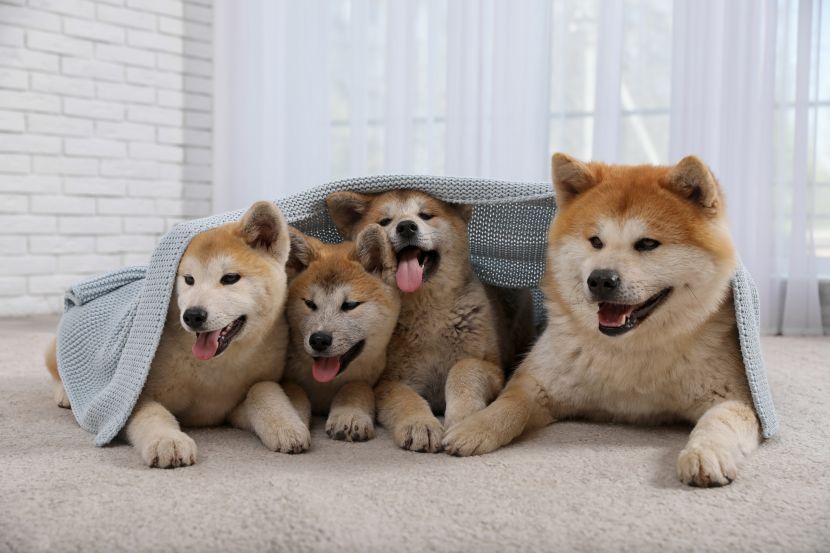
A tall and strong dog with a moody nature and a hostile attitude towards strangers and males of other breeds, he seeks constant physical and mental activity and does not like solitude: otherwise he will demolish your home.
Akita is "beaten" by the voice of a dangerous dog attacking a man.
Most often, she is distrustful and even aggressive towards strangers. That is why socialization is necessary for her, especially obedience exercises. A male Akita is unpredictable towards males of any breed. Owners say that females and long-haired individuals are calmer.
History of the race
Akita inu is an old Japanese breed, and the first records about it come from the seventeenth century. On the island of Honshu, in the province of Akita, the nobility of the time bred these dogs for hunting. After years of selection, "akita matagi" was created. It was an intelligent, loyal and brave dog with a sharp eye and an extraordinary sense of smell. It was used in hunting wild boar and bear, and always in pairs - a male and a female. Their task was to find and hold game until the hunter arrived, to retrieve waterfowl, and they were also good fishing assistants.
In Japan, Akitas were guardians of homes, but also war and fighting dogs. The race almost disappeared at the beginning of the 20th century, but in 1931 it was declared a cultural treasure of the state. Many Akitas died in World War II, as the Japanese army used their skins to make clothing.
Organized Akita breeding in the world began after the war: in the USA, a completely different type of dog of this breed was created, which was recognized by the FCI under the name American Akita. In certain parts of Japan, on the occasion of the birth of a child, Akita statues are given as a symbol of longevity, happiness and health.

Physical characteristics
The Akita Inu is tall: the male is 67 cm at the withers, and the female is 61 cm. From the physical peculiarities, the appearance of the ears stands out, which are small compared to the head and body, and it also has tiny, almost triangular eyes. The space between the eyes is dull brown: a stronger color of the space means a higher price of the dog.
The standard permitted coat colors are: reddish-red, reddish-red with black spots, brindle and white. All of the listed colors (except white) have a "fur" (whitish hair on the sides of the muzzle, cheeks, under the jaw, on the throat, the front of the belly, the underside of the tail and the inner parts of the legs).
Health and life expectancy
Akita lives on average 10 to 15 years. Hereditary diseases of the breed are hip dysplasia, progressive retinal atrophy and reduced activity of the thyroid gland. During the mating period, consult a veterinarian regarding examinations, analyzes and control of puppies. After giving birth, the female is very aggressive and protective of the puppies, so do not touch them for the first few days.
Nutrition and care
Akita can be kept in the yard and in the apartment and tolerates the cold well. It sheds twice a year and requires daily brushing. In the rest of the year, brush the Akita once a week. Otherwise, this dog sheds very little hair. The Akita is tidy, does not have a strong odor and will clean its face like a cat after a meal. An adult Akita is fed once or twice a day, and the amount of meals depends on the type of food. It has a hard time withstanding high temperatures and needs a lot of fresh water.
Temperament
Akita is quiet and does not bark often. He quickly learns the rules of behavior in the house. She is gentle and protective towards children, but be careful if you have rabbits, guinea pigs, and even cats in your home, because she will experience them as prey. This breed requires constant physical and mental activity, but loves a comfortable nap next to its owner. She does not like solitude, so pay attention to that, otherwise she will become destructive.
Remembering Hachik
The Akita's loyalty is best illustrated by the story of Hachiko, Professor Yen's dog who worked at the University of Tokyo in the 1920s. Hachiko came to the professor's home as a puppy. Every day at the bus stop, he greeted the owner who was returning from work and followed him home. One day the professor had a heart attack and did not return home. Hachiko patiently and at the same time welcomed him for the next nine years. The dog was cared for by the professor's relatives, but no one could distract him from his daily vigil.
The memory of Hachiko lives on today: every eighth of April, a ceremony is held at Shibuya Station in Tokyo. In 1934, a sculpture of this dog was erected at the station where Hachiko was waiting for his owner, but it was demolished during the Second World War. In 1947, the sculptor's son erected another sculpture in the same place, which is still there today.
Breed standard
According to the classification of the International Cynological Federation, Akita inu belongs to the 5th FCI group (spitz type and primitive type of dogs), section 5 (Asian spitz and related breeds). It is not subject to an on-the-job test, and the standard under number 255 was last corrected in 2001.


